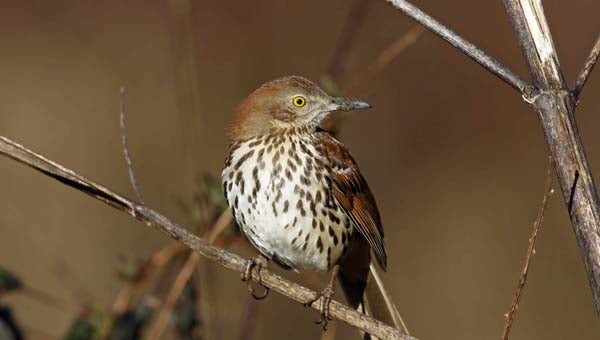The Brown Thrasher, a bird of character
Published 10:00 pm Monday, February 2, 2015

A large brown bird scratches around in the leaf litter, its long red-brown tail enabling it to turn suddenly as it uncovers choice grubs from below the dead leaves. This is the Brown Thrasher, one of Eastern North America’s most charismatic birds and also one of our most accomplished songsters.
Brown Thrashers are found from southern Canada deep into the Southeastern United States and almost as far south as the Mexican border. In the majority of its range the Brown Thrasher is a summer visitor, but here in Western North Carolina we are on the southern border of its all-year-round range with most individuals slipping south into the Piedmont where they will spend the colder months of the year.
A few birds do over-winter in Western North Carolina and are found in the lower and more vegetated areas such as along rivers and in dense, wet thickets. At this time of the year we tend to only hear their deep call-notes and glimpse a red-brown bird skulking deep in the undergrowth.
It is during the spring when the Brown Thrasher comes into its own as the male flies higher and higher into a tree to sing from the very pinnacle of its territory. The rich song seems to reverberate through the slowly greening woodlands where the male is often the first of the spring birds to make an appearance.
The song comprises of pairs of phrases, each one seemingly richer and more guttural than the preceding. It’s one of those songs that epitomize the arrival of spring. As the first flower buds break through the brown soil, the first bird songs break the winter silence and it’s usually the Brown Thrasher that is leading the charge into springtime.
Superficially similar to many of our spotted brown thrushes, the thrasher is actually a member of the Mimic-thrush family and a cousin to the Northern Mockingbird and Gray Catbird, although the similarity stops there. Most mimics tend to have long tails, a somewhat pointed bill that’s suited to fruit, insects and more generalized food, and a complicated song. Thrushes have shorter tails, similar bills and more ethereal sounding songs.
Brown Thrashers spend most of their time on the ground, where they feed on invertebrates under the leaf-litter. They will readily come to bird feeders, but again spend most of the time feeding on seeds that fall down from above. Watching one hammer into a sunflower seed, its beady yellow eye glaring, is certainly an entertaining sight. They tend to skulk under the feeders, rather than sit and feed as does a cardinal.
As with both the catbird and the mockingbird, Brown Thrashers nest in thick bushes where they build an untidy nest of sticks and plant fibers where they lay 4-6 eggs. Unlike most birds their size, young Brown Thrashers can leave the nest after about 9 days, which is probably a defense against predators.
You can’t help but like the Brown Thrasher. A strong looking bird with a powerful voice- you certainly know when he is around the neighborhood.
Simon Thompson has lived in WNC for the past 20 years. He owns and operates his own birding tour company, Ventures Birding Tours online at birdventures.com. He and Chris also own and operate the Asheville Wild Birds Unlimited Store. For more information on any of the birding activities in the area, drop by the store or visit Asheville.wbu.com.

